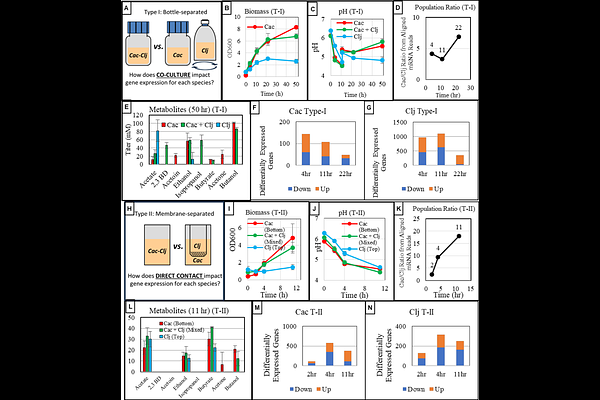Separate, Separated and Together: the Transcriptional Program of the Clostridium acetobutylicum- Clostridium ljungdahlii syntrophy leading to interspecies cell fusion

Separate, Separated and Together: the Transcriptional Program of the Clostridium acetobutylicum- Clostridium ljungdahlii syntrophy leading to interspecies cell fusion
Willis, N. B.; Papoutsakis, E. T.
AbstractSyntrophic cocultures (hitherto assumed to be commensalistic) of Clostridium acetobutylicum and Clostridium ljungdahlii, whereby CO2 and H2 produced by the former feeds the latter, result in interspecies cell fusion involving large scale exchange of protein, RNA and DNA between the two organisms. Although mammalian cell fusion is mechanistically dissected, the mechanism for such microbial-cell fusions is unknown. To start exploring this mechanism, we used RNA sequencing to identify genes differentially expressed in this coculture using two types of comparisons. One type compared coculture to the two monocultures, capturing the combined impact of interactions through soluble signals in the medium and through direct cell-to-cell interactions. The second type compared membrane separated versus unseparated cocultures, isolating the impact of interspecies physical contact. While we could not firmly identify specific genes that might drive cell fusion, consistent with our hypothesized model for this interspecies microbial cell fusion, we observed differential regulation of genes involved in C. ljungdahlii\'s autotrophic Wood-Ljungdahl-Pathway metabolism and genes of the motility machinery. Unexpectedly, we also identified differential regulation of biosynthetic genes of several amino acids, and notably of arginine and histidine. We verified that they are produced by C. acetobutylicum and are metabolized by C. ljungdahlii to its growth advantage. These and other findings, and notably upregulation of C. acetobutylicum ribosomal-protein genes, paint a more complex syntrophic picture and suggest a mutualistic relationship, whereby beyond CO2 and H2, C. acetobutylicum feeds C. ljungdahlii with growth boosting amino acids, while benefiting from the H2 utilization by C. ljungdahlii.